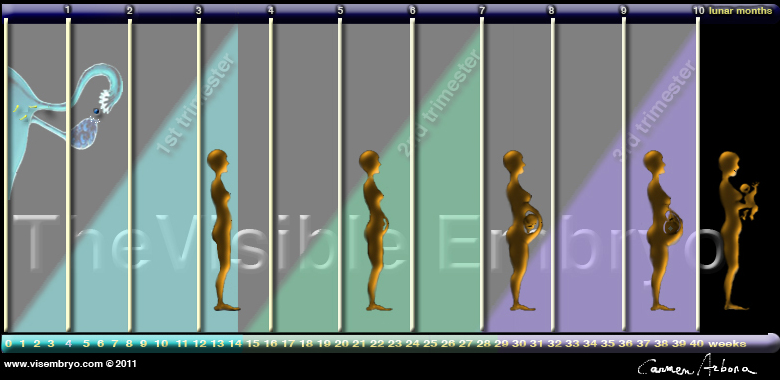|

CLICK ON weeks 0 - 40 and follow along every 2 weeks of fetal development
|
||||||||||||||||||||||||||||
|
Developmental Biology - CRISPR Nested CRISPR: Using Clone-Free DNA Pieces Nested CRISPR DNA fragment insertion steps: The work is published in Genetics, a journal of the Genetics Society of America. Model organisms with a short life cycle such as C. elegans enable researchers to explore both the possibilities and limitations of CRISPR. This work is part of the doctoral thesis of Jeremy Vicencio, awarded with the prestigious INPhINIT fellowship by La Caixa. Vicencio, along with predoctoral researchers Carmen Martínez and Xčnia Serrat, performed hundreds of microinjections into the C. elegans germline to collect thousands of genotypings to solidly demonstrate the efficiency of the new technique. Nested CRISPR uses commercial oligonucleotides for the first step and universal PCR products for the second. This facilitates large-scale experiments making it possible to tag hundreds of genes with fluorescent proteins. Moreover, as Nested CRISPR is modular, additional peptides or proteins of interest can also be combined with fluorescent proteins. The group is currently working on tagging these fluorescent proteins with peptides that allow their degradation in a controlled manner. The modeling diseases in C. elegans group is directed by Dr. Cerón at IDIBELL, with the intention of using Nested CRISPR to replace C. elegans genes with human counterparts. This would prompt use of this small nematode as a multicellular model for study of human mutations associated with disease — of substantial interest to the field of personalized medicine. It is hoped Nested CRISPR could rapidly and efficiently provide a prognosis regarding the pathogenicity of a mutation or genomic variation (known as polymorphisms). Abstract CRISPR-based genome editing methods in model organisms are evolving at an extraordinary speed. Whereas the generation of deletion or missense mutants is quite straightforward, the production of endogenous fluorescent reporters is more challenging. We have developed Nested CRISPR, a cloning-free ribonucleoprotein-driven method that robustly produces endogenous fluorescent reporters with EGFP, mCherry, or wrmScarlet in Caenorhabditis elegans. This method is based on the division of the fluorescent protein (FP) sequence in three fragments. In the first step, ssDNA donors (<=200 bp) are used to insert the 5' and 3' fragments of the FP in the locus of interest. In the second step, these sequences act as homology regions for homology-directed repair using a dsDNA donor (PCR product) containing the middle fragment, thus completing the FP sequence. In Nested CRISPR, the first step involving ssDNA donors is a well-established method that yields high editing efficiencies, and the second step is reliable because it uses universal crRNAs and PCR products. We have also used Nested CRISPR in a non-essential gene to produce a deletion mutant in the first step and a transcriptional reporter in the second step. In the search for modifications to optimize the method, we tested synthetic sgRNAs, but did not observe a significant increase in efficiency. To streamline the approach, we combined all Step 1 and Step 2 reagents in a single injection and were successful in 3 of 5 loci tested with editing efficiencies of up to 20%. Finally, we discuss the prospects of this method in the future. Authors Jeremy Vicencio, Carmen Martínez-Fernández, Xčnia Serrat and Julián Cerón. Supplemental Material available at Figshare: https://doi.org/10.25386/genetics.7629641 Return to top of page | Feb 21, 2019 Fetal Timeline Maternal Timeline News  Caenorhabditis elegans nematodes surround a word cloud during germline development. Gonads were stained for mitotically dividing cells (three pink cells, left image) or major sperm protein (top, red). Top and right gonads have been pseudocolored for artistic effect. Images found in manuscript by Ellenbecker et al., pp. 665–681 of GENETICS Volume 211 Issue 2, February 2019.
|
||||||||||||||||||||||||||||

